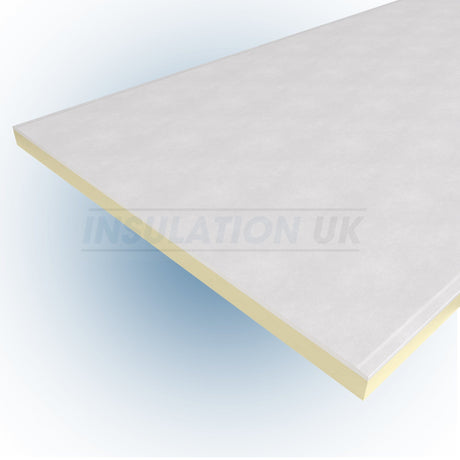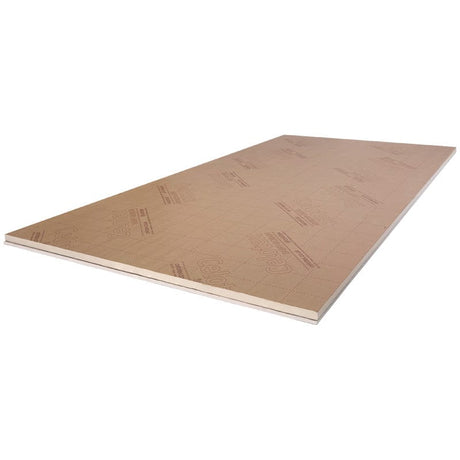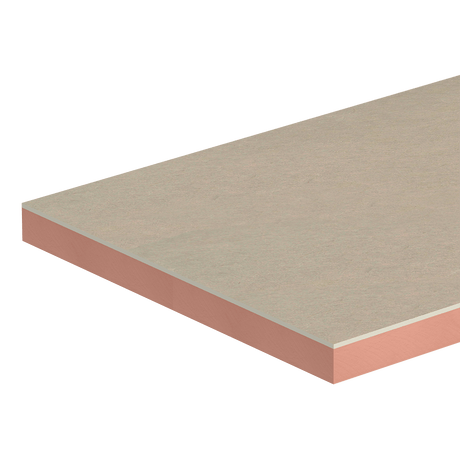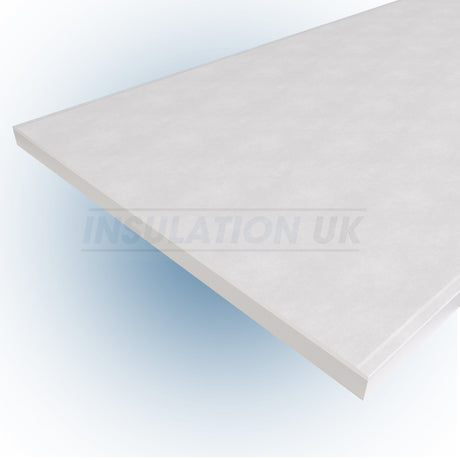Tekwarm
29.5mm Tekwarm PIR Insulated Plasterboard 2.4m x 1.2m
£34.70 Inc VAT £28.92 Ex VATUnit price /UnavailableIn stockTekwarm
32.5mm Tekwarm PIR Insulated Plasterboard 2.4m x 1.2m
£33.08 Inc VAT £27.57 Ex VATUnit price /UnavailableIn stockTekwarm
37.5mm Tekwarm PIR Insulated Plasterboard 2.4m x 1.2m
£31.96 Inc VAT £26.63 Ex VATUnit price /UnavailableIn stockTekwarm
42.5mm Tekwarm PIR Insulated Plasterboard 2400mmx 1200mm
£40.15 Inc VAT £33.46 Ex VATUnit price /UnavailableIn stockTekwarm
52.5mm Tekwarm PIR Insulated Plasterboard 2400mmx 1200mm
£38.84 Inc VAT £32.37 Ex VATUnit price /UnavailableIn stockTekwarm
62.5mm Tekwarm PIR Insulated Plasterboard 2400mmx 1200mm
£42.78 Inc VAT £35.65 Ex VATUnit price /UnavailableIn stockTekwarm
72.5mm Tekwarm PIR Insulated Plasterboard 2400mmx 1200mm
£48.71 Inc VAT £40.59 Ex VATUnit price /UnavailableIn stockTekwarm
82.5mm Tekwarm PIR Insulated Plasterboard 2400mmx 1200mm
£61.02 Inc VAT £50.85 Ex VATUnit price /UnavailableIn stockTekwarm
92.5mm Tekwarm PIR Insulated Plasterboard 2.4m x 1.2m
£66.34 Inc VAT £55.28 Ex VATUnit price /UnavailableIn stockTekwarm
102.5mm Tekwarm PIR Insulated Plasterboard 2.4m x 1.2m
£69.71 Inc VAT £58.09 Ex VATUnit price /UnavailableIn stockCelotex
37.5mm Celotex PL4025 PIR Insulated Plasterboard 2.4m x 1.2m
£31.96 Inc VAT £26.63 Ex VATUnit price /UnavailableIn stockCelotex
52.5mm Celotex PL4040 PIR Insulated Plasterboard 2.4m x 1.2m
£38.84 Inc VAT £32.37 Ex VATUnit price /UnavailableIn stockCelotex
62.5mm Celotex PL4050 PIR Insulated Plasterboard 2.4m x 1.2m
£42.78 Inc VAT £35.65 Ex VATUnit price /UnavailableIn stockCelotex
72.5mm Celotex PL4060 PIR Insulated Plasterboard 2.4m x 1.2m
£48.71 Inc VAT £40.59 Ex VATUnit price /UnavailableIn stockKingspan
37.5mm Kingspan Kooltherm K118 Insulated Plasterboard 2.4m x 1.2m 21 Per Pallet
£1,424.59 Inc VAT £1,187.16 Ex VATUnit price /UnavailableIn stockKingspan
42.5mm Kingspan Kooltherm K118 Insulated Plasterboard 2.4m x 1.2m 18 Per Pallet
£1,258.96 Inc VAT £1,049.13 Ex VATUnit price /UnavailableIn stockKingspan
52.5mm Kingspan Kooltherm K118 Insulated Plasterboard 2.4m x 1.2m 15 Per Pallet
£1,111.97 Inc VAT £926.64 Ex VATUnit price /UnavailableIn stockKingspan
57.5mm Kingspan Kooltherm K118 Insulated Plasterboard 2.4m x 1.2m 14 Per Pallet
£1,110.60 Inc VAT £925.50 Ex VATUnit price /UnavailableIn stockKingspan
62.5mm Kingspan Kooltherm K118 Insulated Plasterboard 2.4m x 1.2m 12 Per Pallet
£1,015.20 Inc VAT £846.00 Ex VATUnit price /UnavailableIn stockKingspan
72.5mm Kingspan Kooltherm K118 Insulated Plasterboard 2.4m x 1.2m 11 Per Pallet
£977.57 Inc VAT £814.64 Ex VATUnit price /UnavailableIn stockKingspan
82.5mm Kingspan Kooltherm K118 Insulated Plasterboard 2.4m x 1.2m 9 Per Pallet
£947.70 Inc VAT £789.75 Ex VATUnit price /UnavailableIn stockTekwarm
22.5mm Tekwarm EPS Thermal Basic Board 2.4m x 1.2m 9.5mm Plasterboard
£21.82 Inc VAT £18.18 Ex VATUnit price /UnavailableIn stockTekwarm
25.5mm Tekwarm EPS Insulated Plasterboard 2.4m x 1.2m
£23.83 Inc VAT £19.86 Ex VATUnit price /UnavailableIn stockTekwarm
37.5mm Tekwarm EPS Insulated Plasterboard 2.4m x 1.2m
£27.96 Inc VAT £23.30 Ex VATUnit price /UnavailableIn stock
Our premium selection of insulated plasterboard caters to the diverse needs of both DIY enthusiasts and professional contractors. Our products seamlessly blend superior insulation properties with the simplicity of plasterboard installation, offering an optimum solution to improve the thermal efficiency of any space.
What is Insulated Plasterboard?
Insulated plasterboard, also known as thermal laminate, is a popular building material comprising a plasterboard sheet and an insulating material layer. It's designed to enhance the thermal performance of internal walls and roofs without significantly increasing wall depth. Our plasterboard is available in various sizes, thicknesses, and finishes, ensuring there's a perfect fit for every project.
Applications of Insulated Plasterboard
Ideal for lining internal walls, especially brick walls needing insulation and dry-lining, insulated plasterboard is a quicker, cost-effective alternative to traditional methods. Its ease of installation, using nails, screws, or adhesive, makes it a favourable option for many DIY projects.
Benefits of Using Insulated Plasterboard
- Improved Thermal Efficiency: Achieve stable indoor temperatures and reduce energy consumption.
- Ease of Installation: Streamline construction times with integrated insulation and plasterboard.
- Space Saving: Optimize insulation without sacrificing interior space, ideal for renovations.
- Enhanced Indoor Comfort: Minimize drafts and cold spots for a uniformly comfortable environment.
- Versatility: Select from various thicknesses and insulation materials, including PIR, phenolic, and mineral wool, to meet specific project needs.
- Enhanced Building Performance: Meet or exceed energy efficiency regulations, contributing to sustainable construction.
- Cost-Effectiveness: Enjoy long-term savings on energy costs, making it a wise investment.
- Environmental Impact: Contribute to sustainability by reducing greenhouse gas emissions.
Choosing the Right Insulation Type
PIR Insulated Plasterboard
- Thermal Performance: PIR insulated plasterboard offers high thermal efficiency with a lower thickness compared to other insulating materials. It has a high R-value (thermal resistance), meaning it provides excellent insulation with less material.
- Cost: Typically, PIR is more expensive than EPS but can be more cost-effective in the long run due to its superior thermal performance, reducing heating and cooling costs.
- Applications: PIR is ideal for applications where space is at a premium and high thermal efficiency is required. It's suitable for both new constructions and renovations, including walls, roofs, and floors.
- When to Use: Choose PIR when you need the best insulation performance in the thinnest possible profile, especially in areas with limited space.
EPS Insulated Plasterboard
- Thermal Performance: EPS has a lower R-value than PIR, meaning it's less thermally efficient per inch of thickness. However, it's still a good insulator and can be used in a variety of applications.
- Cost: EPS is generally more affordable than PIR, making it a cost-effective solution for larger areas or where budget constraints are a significant consideration.
- Applications: Due to its versatility, EPS can be used in walls, floors, and roofs. It's particularly well-suited to large-scale applications where cost-effectiveness is crucial.
- When to Use: EPS is the choice when budget is a significant concern or for large projects where the slightly lower thermal performance can be compensated for by a thicker insulation layer.
HP+ Insulated Plasterboard
- Thermal Performance: HP+ insulated plasterboard is designed to provide enhanced thermal performance, potentially exceeding that of standard PIR boards. It often incorporates advanced materials or composites to offer superior insulation.
- Cost: The cost of HP+ insulated plasterboard can be higher due to its advanced technology and materials, making it a premium option.
- Applications: This type of plasterboard is suited for high-end constructions or renovations where the highest possible insulation performance and energy efficiency are required.
- When to Use: HP+ is ideal when energy efficiency is a top priority, and the budget allows for the use of the most advanced insulating materials available.
Conclusion
- Space Limited Projects: Choose PIR for its high thermal efficiency in a slim profile.
- Budget-Conscious Projects: Opt for EPS when cost is a significant factor, and a thicker insulation layer is acceptable.
- High-End Energy Efficiency Projects: Use HP+ insulated plasterboard when the project demands the highest level of thermal performance and energy efficiency, and the budget can accommodate premium materials.
Selecting the Appropriate Plasterboard Type
Various plasterboard laminates cater to specific construction requirements, including thermal insulation, fire resistance, moisture resistance, and acoustic insulation. Choose the type that best suits your project's needs, whether it's standard, fire-resistant, moisture-resistant, or acoustic plasterboard.
-
Standard Plasterboard: The core plaster material is encased in a strong paper liner. This type is used for general applications in walls and ceilings.
-
Fire Resistant Plasterboard: Contains fibres or additives that improve its fire resistance properties. It's used in areas where enhanced fire protection is needed.
-
Moisture Resistant Plasterboard: Has a water-repellent additive in the core, making it suitable for humid areas like bathrooms and kitchens.
-
Acoustic Plasterboard: Designed to provide sound insulation. It's denser and may include special sound-absorbent materials.
-
Thermal Plasterboard: Comes with an insulating layer attached to the back of the plasterboard, aiming to improve the thermal efficiency of buildings.
-
Impact Resistant Plasterboard: Contains fibres or reinforced materials to withstand greater impacts. Ideal for high-traffic areas or where greater durability is required.
-
Vapour Barrier Plasterboard: Has a layer that acts as a moisture vapor barrier to prevent condensation. It's useful in climates where interior condensation is a problem.
Our Top Insulated Plasterboard Brands
- Tekwarm Insulated Plasterboard: Combines high-performance insulation with premium plasterboard for thermal efficiency and aesthetic finish.
- Kingspan Insulated Plasterboard: A two-in-one solution integrating superior insulation materials with high-quality plasterboard.
- Celotex Insulated Plasterboard: Features a PIR foam insulation layer bonded to high-quality plasterboard, streamlining installation and enhancing thermal performance.



























